
Was the timing of the July 23 trespass notice served by 100 New Zealand Police on occupiers at Ihumātao simply a random date? Or was the date chosen for its historical significance to signal a coordinated advancement by New Zealand’s National Security State? This Ihumātao Class Lesson explores the possibility that New Zealand’s Deep State players encoded the escalation of July 23 in an attempt to steer the narrative away from a full-blown crisis of legitimacy for the Neo-Colonial Patriarchy that controls New Zealand.
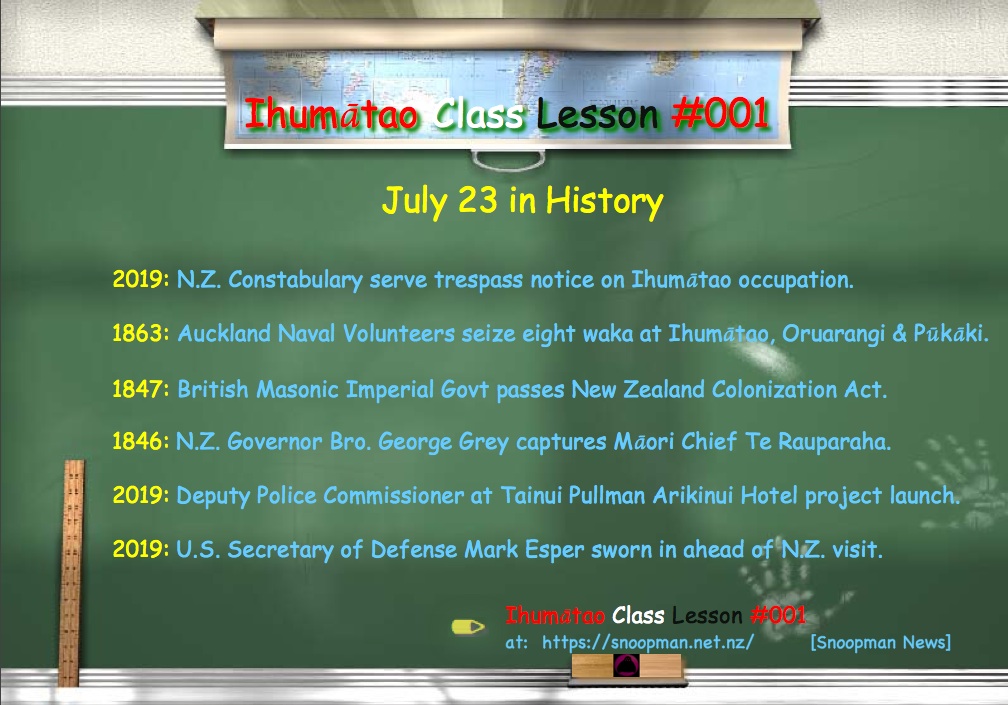
By Snoopman, 13 August 2019
July 23 2019: N.Z. Police serve trespass notice on Ihumātao occupation.
On July 23 2019, 200 New Zealand Police served a trespass notice on manu whenua occupiers at Ihumātao, located by the Manukau Harbour in Auckland City, or Tamaki Makaurau. The court-ordered trespass notice demanded the “squatters” group – Protect Ihumatao* – vacate an 81-acre block of land confiscated off Māori in 1865 during the Great War for New Zealand.
The 81 acres that Scotch settler Gavin Struthers Wallace bought from the Colonial Crown’s Waste Lands Office in 1866 for £658, is now known as the Oruarangi Block. A few hundred supporters of the Protect Ihumātao Campaign are occupying with tents to prevent an imminent housing development, while a peaceful resistance force of several thousand reserves watch the narrative unfold – ready to swell the front-line if needed.
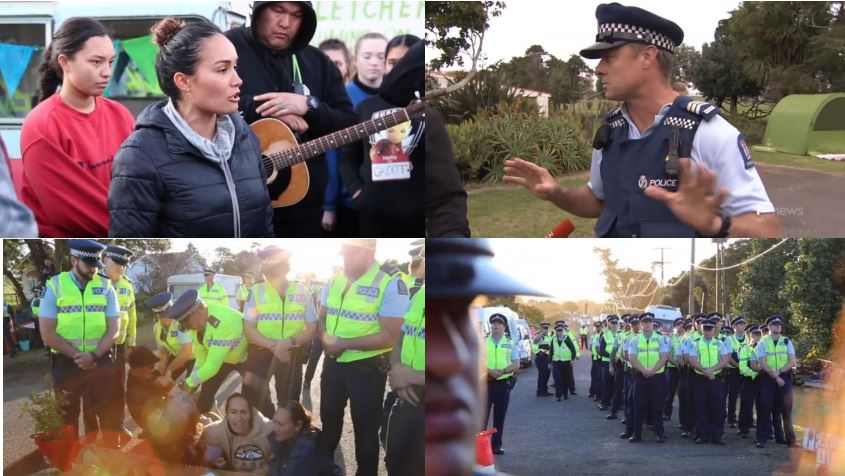
The transnational bank-owned construction consortium, Fletcher Building, bought the 81-acre paddocked property off the Gavin H Wallace Limited in late December 2016, reportedly for a sum of $19 million. Fletcher Residential, whose parent company is 54%-owned by three transnational banks – HSBC, JPMorgan Chase and Citibank – plans to develop residential housing on the site, which is located next to the Puketaapapa volcano at the edge of the Otuataua Stonefields Historic Reserve. The Otuataua Stonefields, along with the burial caves within the Oruarangi Block, are considered sacred by the manu whenua of Ihumātao. This trespass notice – served on behalf of Fletcher Building Limited – in effect riffed off Colonial-era history.
Te Kawerau a Maki iwi kaumatua Mr Te Warena Warren Jack Taua was present at the Police eviction of the Ihumātao occupation group on July 23. Indeed, Warren Taua was interviewed on the Māori King’s Kiingitanga Live Facebook channel – with the Neo-Colonial Crown’s Police Constabulary in the background.
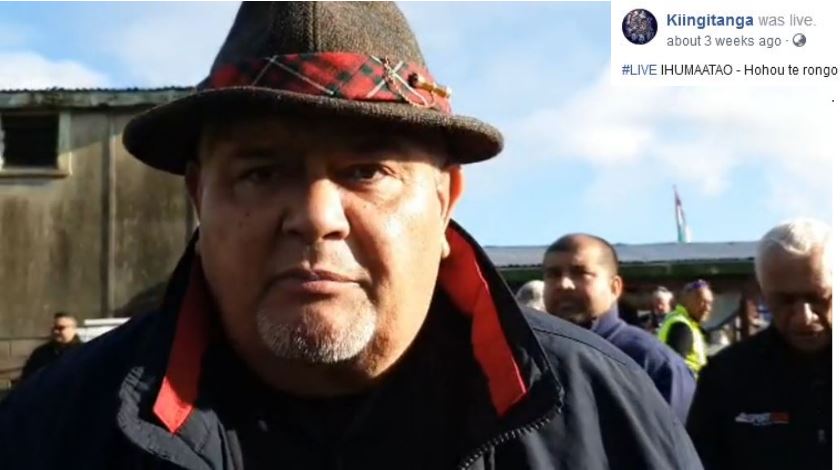
The Crown Constabulary’s move to trespass the manu whenua occupiers occurred after a series of events that belied a coordinated escalation starting late June. Police Deputy-Commissioner Wally Haumaha accompanied Te Kawerau a Maki kaumatua Mr Te Warena Warren Jack Taua and TOA architects to Te Puea Marae in Mangere Bridge on Thursday 20 June, after being turned down by both the Ihumātao occupation group – SOUL, as well as Makaurau Marae in Ihumātao – who back the occupation. Campaign leader of Save Our Unique Landscapes (SOUL), Pania Newton, and other SOUL members were drawn to reluctantly attend the June 20 hui. The presence of the Deputy-Police Commissioner with a couple of Police revealed the fraud of the surface reason, which was supposedly to show off TOA architects’ revamped building model for the Fletcher development at Ihumātao. Police DC Wally Haumaha’s presence signalled an encoded threat to the Ihumātao occupation group, whom were drawn to the hui once they heard Te Puea Marae had agreed to host the revamped housing design hui.
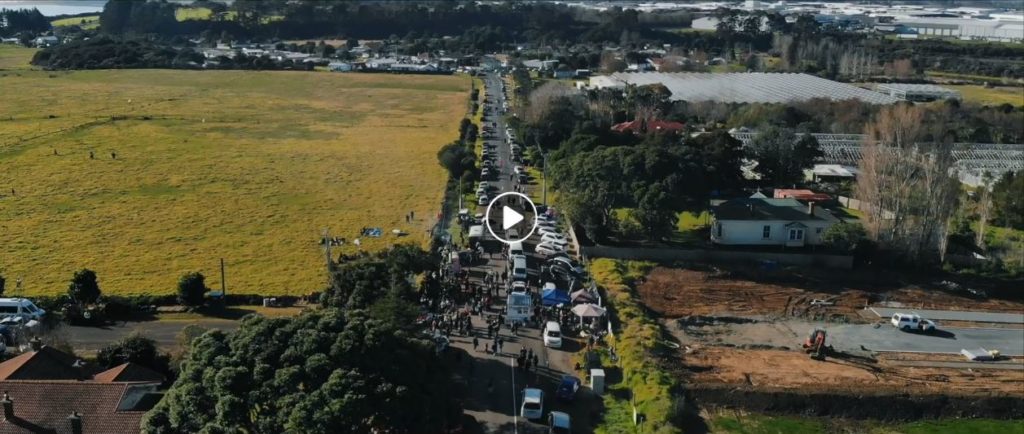
The N.Z. Police Constabulary’s July 23 ‘trespass notice’ move on Ihumātao – in the company of Fletcher Residential CEO Steve Evans and Mr. Taua – has historical charge. As we shall see, this historical charge is particularly galling for its inherent irony. Not least, because in mid-1857, Ihumātao was place where the first Māori King, Pōtatau Te Wherowhero, was elected – as The Snoopman reported in “Dispatch from Ihumātao #001 – The Kingitanga Connection”. As you will also see soon – Mr. Warren Taua, who was awarded the New Zealand Order of Merit for his services to Māori and conservation in the Queen’s Birthday Honours List of 2004, had a busy day on July 23 .
But, before revisiting July 23 2019 – a few key July 23 events from the Colonial-era are retrieved from the ‘national memory hole’ for their significance to show that N.Z’s National Security State may well be riffing off history to signal to key players that they are seeking to control the unfolding narrative.
July 23 1863: Naval Volunteers seize 8 waka at Ihumātao & Pūkāki.
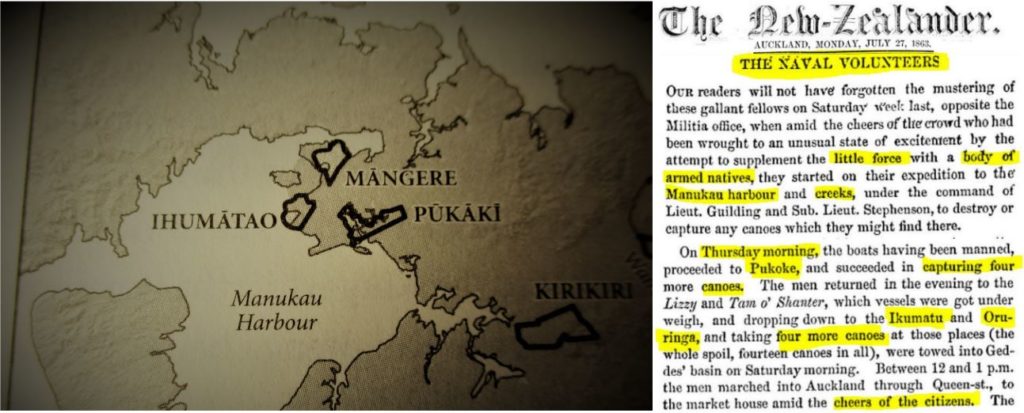
On July 23 1863, the Auckland Naval Volunteers seized eight waka at Ihumātao, Oruarangi and Pūkāki on the Manukau Harbour, after ‘the Natives’ of the Mangere District were served an ‘eviction notice’ 13 days prior, on July 10. This ultimatum by Proclamation demanded Māori of the Manukau District – and elsewhere in the southern parts of the Tamaki region – to pledge loyalty to the ‘British’ Queen, Victoria of Saxe-Coburg and Gotha, and to hand over their weapons.6 Because the Auckland Naval Volunteers confiscated their water transport, Māori of Ihumātao were forced to walk to the Waikato where war was being waged against the indigenous people of New Zealand by Imperial and Colonial forces under the command of Freemason Governor Bro. George Grey.7
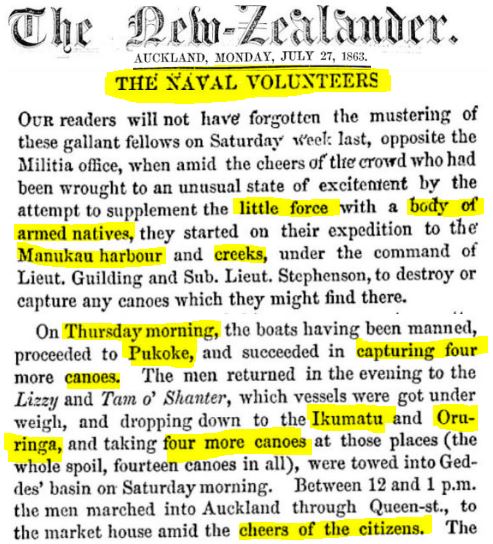
In his 1864 book, The Maori King, Freemason Bro. John Gorst wrote this about passage about the pretext for the evictions:
“the Government had not a single Maori policeman upon whose obedience they could depend. It was therefore resolved to drive these poor people men and women from their homes and confiscate their lands. There was no difficulty in finding a pretext. They were Maoris and relatives of Potatau.”
July 23 in New Zealand history becomes more significant when we learn that two key events were, in effect, decisive moves by the British Crown to assert authority in highly symbolic and material ways.
July 23 1847: British Imperial Govt passes N.Z. Colonization Act.

On July 23 1847, the British Masonic Imperial Government passed the New Zealand Colonization Act, to regulate the New Zealand Company’s colonization of New Zealand. This move officially endorsed the utopian vision of the New Zealand Company’s colonization scheme, which was given intellectual shape by Edward Gibbon Wakefield’s book, The Art of Colonization. When the Colonists’ were confronted King Pōtatau Te Wherowhero’s edict to halt land sales in June 1858, they began plotting war to put down the ‘Maori rebellion’.
July 23 1846: Governor Grey captures Chief Te Rauparaha.
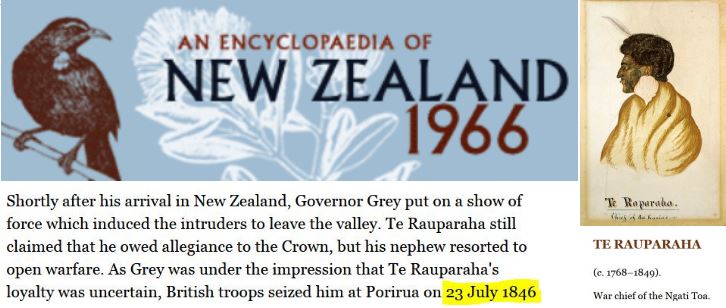
On July 23 1846, Freemason Governor Bro. George Grey sent a small war party to capture Ngāti Toa Chief Te Rauparaha at his Taupō pā in Porirua, near Wellington, or ‘Poneke’. Chief Te Rauparaha – whom played a leading role in the devastating inter-tribal Musket Wars (1818-1840) – was captured because Bro. Grey. The Governor believed the seasoned warrior was playing a double game despite professed loyalties to the Crown, and so he sought to diminish Te Rauparaha’s mana, or sovereignty, and weaken Ngāti Toa, amid fighting between Wellington settlers and Te Rauparaha’s nephew, Te Rangihaeata. During the dawn raid, the aging rangatira attempted blows with his taiaha, but he was overwhelmed, chained and detained on the HMS Calliope for 10 months.
July 23 2019: Tainui launches Pullman Arikinui Hotel project
On July 23 2019 – and on the same day that 100 New Zealand Police moved on Ihumātao to serve a trespass notice on the indigenous occupiers – the élite of the large corporatized Waikato Tainui tribe, including King Tuheitia, were at the launch of the Te Arikinui Pullman Hotel Project near Auckland International Aiport – just five minutes drive from Ihumātao.

23 July 2019 on Kiingtanga Live: [L] Te Warena (Warren) Taua and Fletcher Residential CEO (red ring) at Ihumātao with Police … later the same day, [R] Mr. Taua speaks at the Tainui-Kiingitanga launch of the Te Arikinui Pullman Hotel Project, while to his far left is the uniformed Deputy Police Commissioner, Wally Haumaha (red ring – seated, then standing).
As none other than Te Warena Taua spoke, a Policeman seated in the front-row was chuckling while the kaumatua of Te Kawerau a Maki made his korero amusing.
It turns out this Policeman is none other than Deputy Commissioner Wally Haumaha. This ground-breaking ritual event was also broadcast on the Māori King’s Kiingitanga Live Facebook channel. In other words, the Te Kawerau a Maki kaumatua, Warren Taua – who was on the scene at the early morning the Police eviction at Ihumātao, and later on the day of July 23 – Mr Taua was also speaking at the Te Arikinui Pullman Hotel ground-breaking ritual – and was filmed at both locations by the Kiingitanga Live Facebook channel.

Meanwhile – the SOUL campaigners a few miles away anxiously called-out via social media and other mediums for support to bolster their front-line resistance to the Police Constabulary’s counter-occupation.
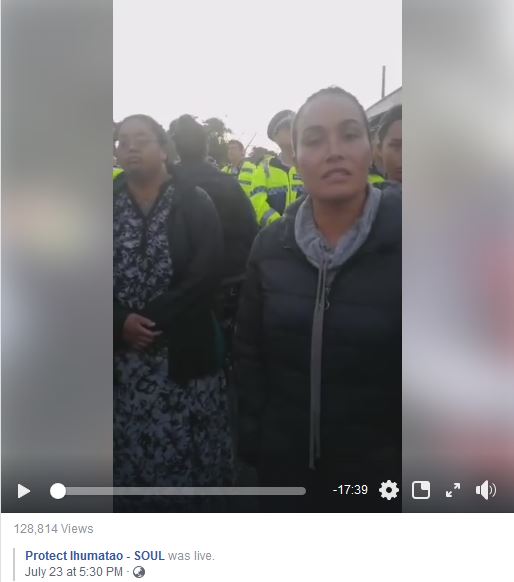
While Police Deputy Commissioner Wally Haumaha was attending the Tainui ground-breaking ritual for the Te Arikinui Pullman Hotel near Auckland International Airport, New Zealand’s National Security State, the Defense Minister and the Prime Minister were anticipating VIP visits a few weeks ahead that would signal the Ardern Coalition Government’s new-found enthusiasm for for the U.S.-NATO military empire’s Global War on Terror – in the aftermath of the Christchurch Mosques Massacre of March 15 2019.
July 23 2019: U.S. Defense Secretary sworn in ahead of N.Z. visit.
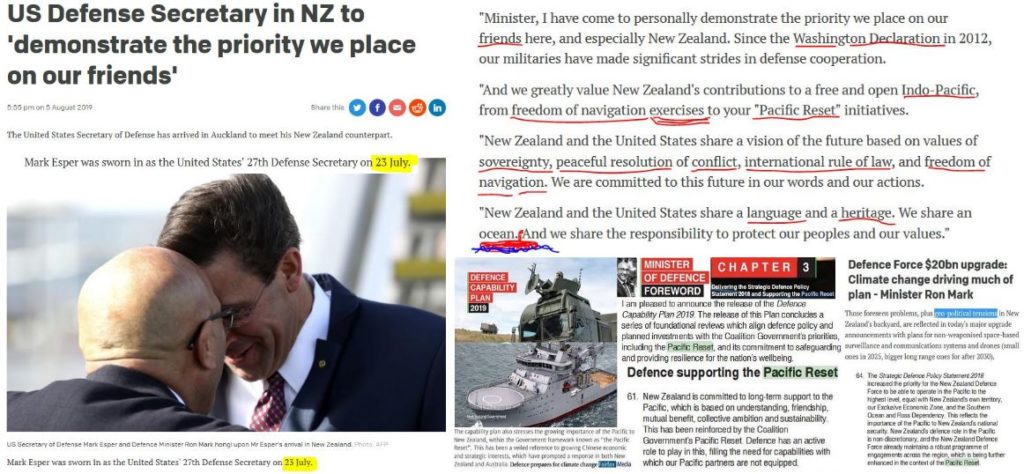
On the very same July 23, a new U.S. Secretary of Defense, Mark Esper, was sworn into office. Esper, who hongi-ed N.Z. Defence Minister Ron Mark upon his arrival in New Zealand on August 5th, said that the United States and New Zealand share a language, a heritage and an ocean. In his address to New Zealand’s Neo-Colonial Government Ministers, Esper added that the United States greatly values and shares “a vision of the future based on values of sovereignty, peaceful resolution of conflict, international rule of law, and freedom of navigation.” Moreover, the American Government appreciated the New Zealand Government’s ‘Pacific Reset’ Defence initiatives – that was clearly signalled in the 2019 Defence Force Strategic Plan. This Pacific Reset appears to have occurred as a result of the Christchurch Mosques Massacre, which produced a political shock that saw the Ardern Coalition Government commit to the $20 billion military upgrade set in motion by the Key Coalition Government in 2014.

This is significant, because the same week that Epser visited New Zealand – the NATO Secretary-General also visited, meaning that the New Zealand National Security State coordinated these visits, knowing they would occur a couple of weeks after the N.Z. Police’s planned to escalate the Ihumatao situation with the ‘trespass notice’ of July 23.
July 23 2019: Where was Wally during the Ihumātao operation?
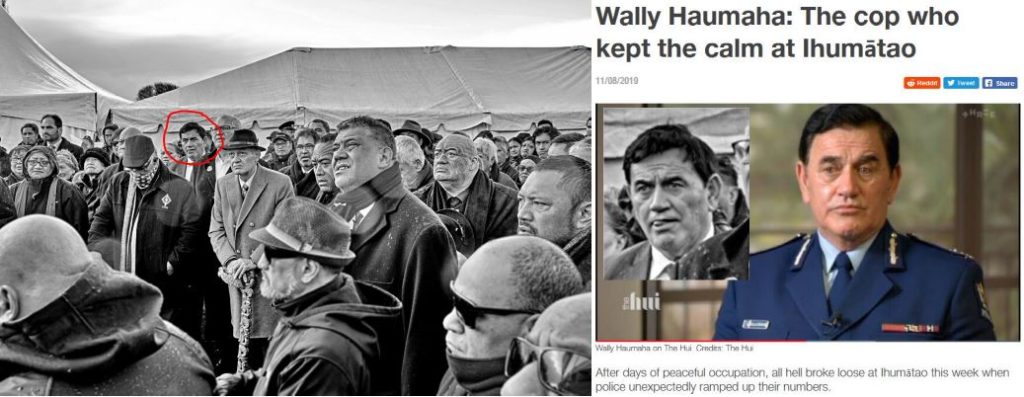
The question then arises – what was the need for a uniformed Deputy Police Commissioner among the crème de la crème of the Pākehā-Māori corporate New Zealand at the Tainui joint venture project with Pullman Hotels and Auckland Airport? And where was Wally during opening phases the Ihumātao operation on July 23? If he was not on the ground – why was he was not there, given that he accompanied Te Warena Taua to Te Puea Marae on Thursday 20 June?
And is the unfolding narrative intended to drive a wedge between the hold-fasts of the Māori patriarchy and men of the Māori patriarchy that don’t feel threatened by positive feminist-inspired wahine toa acting with the whakaaro of whenua-land protectors?
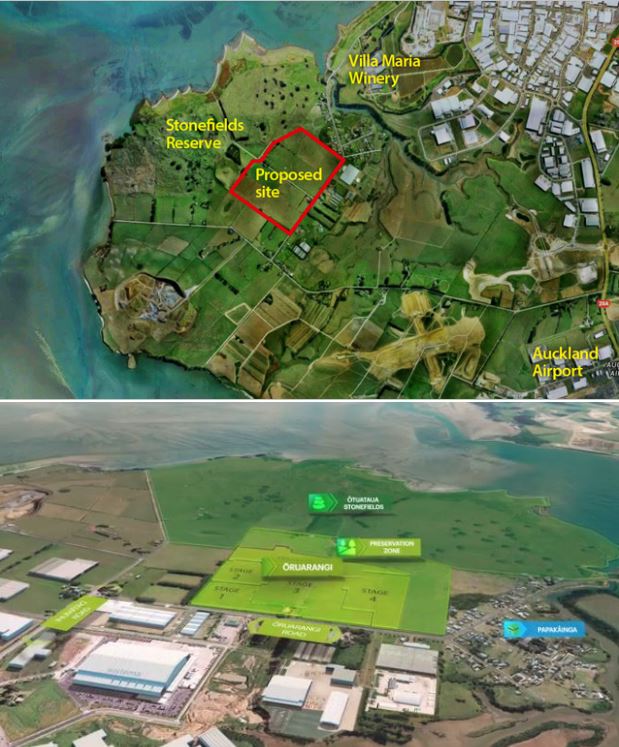
Uncanny Timing? On July 23 2019, or 156 years to the day that the Auckland Naval Volunteers confiscated eight waka from Ihumātao, Oruarangi and Pūkāki – approximately 100 Neo-Colonial Constabulary served an eviction notice on the SOUL-led occupation at Oruarangi on behalf of transnational bank-owned construction consortia, Fletcher Building.
It appears, then, that N.Z.’s National Security State – which includes the Police – are riffing off history. Wally Haumaha has split loyalties between his ties to Tainui, the Kingitanga and his proximity to Warren Taua, while also wearing the Deputy Police Commissioner’s hat. Haumaha’s split loyalties were apparent on July 23, when he was in uniform at the groundbreaking ritual for Tainui joint venure Te Arikinui Pullman Hotel project, sitting in the front row – while Te Kawerau a Maki iwi kaumatua Warren Taua spoke in the presence of Kingi Tuheita. When it is recalled that on July 23 1846, Chief Te Rauparaha was captured by British Navy personnel on orders of Governor Bro. George Grey, who did not trust the Ngāti Toa chief because of his split loyalties amid warring between Wellington settlers and Māori fighting with Te Rauparaha’s nephew, Te Rangihaeata – it becomes apparent that the National Security State is playing Wally Haumaha.
The playing of the Māori Deputy Commissioner of Police like an expendable knight in a game of Neo-Colonial chess, becomes more apparent when the escalation of the Monday evening of August 4 2019 are recalled. The events of that evening will be explored in Ihumātao Class Lesson #002, and located in its place on the unfolding narrative arc of the Ihumātao Occupation story, with the objectives of the National Security State, the Neo-Colonial Crown, Auckland Council and transnational banking owners of the Fletcher Building consortium revealed.
July 23: Riffing off History?
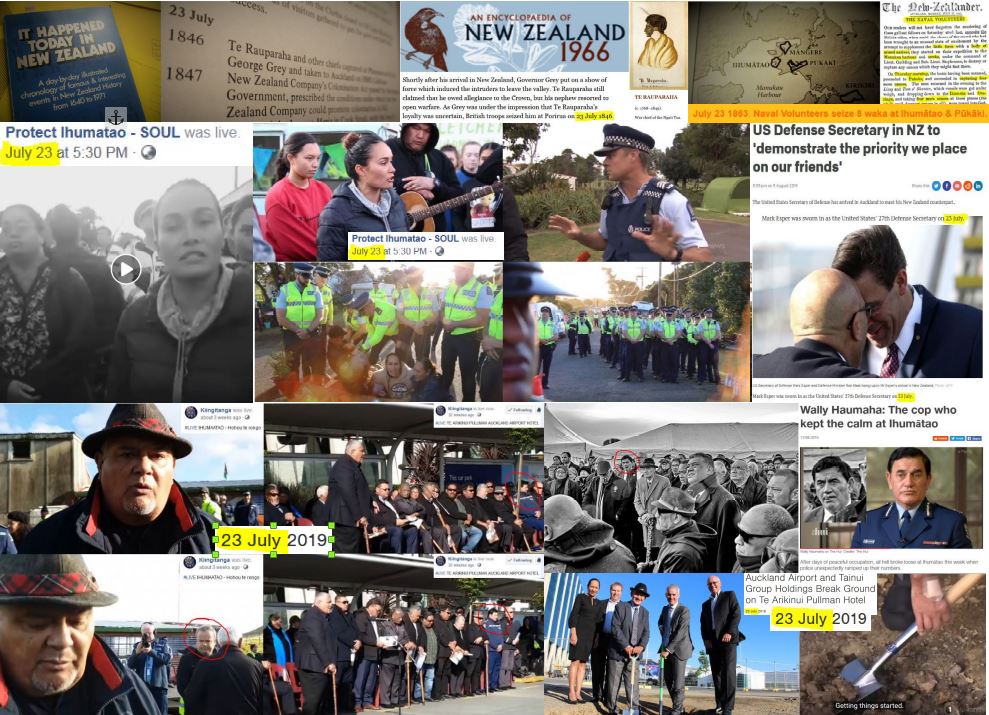
Is the historical event of eight waka being confiscated at Ihumātao, Oruarangi and Pūkāki on July 23 1863, or 13 days after ‘the Natives’ of the Mangere District were served an ‘eviction notice’ – merely coincidental?
This July 23 1863 waka confiscations event by the Auckland Naval Volunteers are a potent historical referent. Because these canoe seizures occurred after Freemason Governor Bro. George Grey’s ‘eviction notice’ was received on by Mangere District ‘Natives’ on July 10, the Police Constabulary’s eviction of the Ihumātao occupation group on July 23 2019 becomes more significant.
Is the historical event of the British Masonic Imperial Government passing the New Zealand Colonization Act, to regulate the New Zealand Company’s colonization of New Zealand on July 23 1847 – also simply a coincidence?
The passing of the New Zealand Colonization Act on July 23 1847 gains more potency given the Police Constabulary served a trespass notice on the Ihumātao occupation group on July 23 2019. Because this New Zealand Colonization Act of 1847 regulated the colonization schemes of the New Zealand Company, and because it was at Ihumātao that the first Māori King was elected in June 1857, and becuase King Pōtatau Te Wherowhero’s edict to halt land sales in June 1858 challenged the Colonists’ ideas about land tenure, the Colonists began plotting war to put down the ‘Māori rebellion’. Therefore, the July 23 1847 passage of the New Zealand Colonization Act is has become a historically-charged event given the Police Constabulary’s eviction of the Ihumātao occupation group on July 23 2019.
Is the historical event of Freemason Governor Bro. George Grey’s capture of Ngāti Toa Chief Te Rauparaha in Porirua, near Wellington on July 23 1846 – just a coincidence?
The capture of Ngāti Toa Chief Te Rauparaha at his Taupō pā in Porirua near Wellington, or ‘Poneke’ on July 23 1846 becomes more significant in light of the Police Constabulary’s eviction of the Ihumātao occupation group on July 23 2019. Since Police Deputy Commissioner Wally Haumaha was present in uniform at the Tainui groundbreaking launch ritual of the Te Arikinui Pullman Hotel near Aucklnd International Airport on July 23 2019, his loyalties appear to be split. When it is recalled that Governor Bro. George Grey had Chief Te Rauparaha captured to diminish the Ngāti Toa warrior’s capacity to be a threat, because his professed loyalty to the Crown were suspected to be questionable amid battles between his the chief’s nephew, Te Rangihaeata and Wellington Colonists – the timing of Police raid on the Ihumātao occupation group – led most visibly by whenua warrior, Pania Newton, becomes more historically charged.
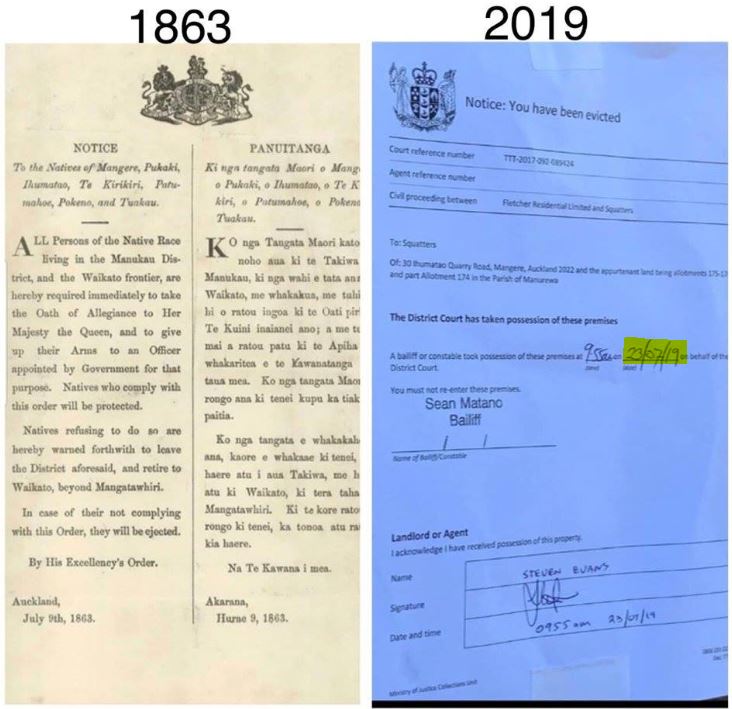
Those apparent split loyalties are amplified when it is revealed that the Police Deputy-Commissioner accompanied Te Kawerau a Maki kaumatua Mr Te Warren Taua and TOA architects to Te Puea Marae on Thursday 20 June 2019. This hui was called by Warren Taua on the pre-text that he wanted the Ihumātao community to see the revamped Oruarangi Block housng development – that includes an 8-hectare wetland buffer zone which was a modified version of the buffer zone designated in the Auckland Council’s Manukau District Plans in 2014. Yet, the presence of Wally Haumaha, with two or three Police officers, not only signalled a visible threat to the SOUL group that attended reluctantly, and foreshadowed an escalation in the dispute. It communicated the Police Deputy-Commissioner’s unsafe, unsound, and unwise proximity to Pania Newton’s uncle, and Fletcher Building’s Dial-a-Kaumatua – Mr Warren Taua.
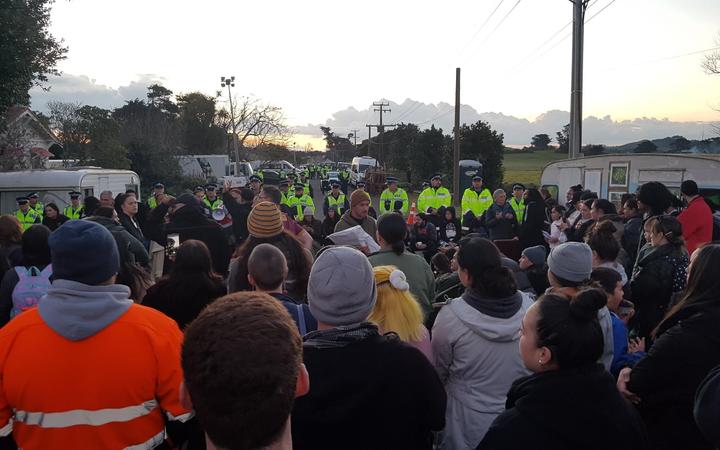
To be super-clear, it is not that Wally Haumaha cannot participate in Tainui and Kingitanga hui. But, his judgement for being so visible at this time is questionable. Has the Police DC has been used as an expendable knight in a game of Neo-Colonial Chess by the National Security State (which includes the Police)? His presence at Te Puea Marae on June 20, with Warren Taua and Toa architects, signalled a visible threat. This is ironic, because it was Wally Haumaha who expressed disappointment as a Māori liaison Police officer, along with other Māori Police officers, whom were excluded from foreknowledge of the Operation Eight Raids of October 15 2007 – in which Tūhoe activist Tame Iti was accused of being a terrorist guerilla leader of a nationwide network. In late 2007, Haumaha held the view that Māori Police officers could have talked with the targets of the raids to find out what they were doing, and they could have de-escalated the situation without traumatizing entire rural communities. When those epic Crown-sponsored multi-season news psy-op episodes are recalled, the current dispute over the Ihumātao occupation becomes more fascinating.
Because it appears that the Police have not thoroughly investigated the Ihumātao case to weigh all the evidence, all the events chronologically, and all the players. Moreover, the presence of Tainui people at the eviction and the Tainui-Pullman events suggests that at least a faction of Kingitanga supporters were visibly supporting the Neo-Colonial Court’s casting of mana whenua at Ihumātao as ‘squatters’.
The framing of mana whenua as ‘squatters’ leads to more questions.
What work has the Police Constabulary performed to test in fact, evidence and affidavits whether Fletcher Building has lawful legal title, or whether the ancestral claims to native title over-ride the fee simple property title due to the meandering machinations of multiple players, institutions and jurisdictions? Did the Police simply act on a squatters court order? How is it good enough that persons claiming to be manu whenua are deemed to be ‘squatters’? How is this progress since 1863 when their apparent ancestors were termed “Persons of the Native Race” by Freemason Governor Bro. George Grey’s July 9th order to submit to his authority or leave quietly under the threat of ejection?
What role did the Kingitanga play in the Police eviction of July 23? Was it simply a techie with access to the Kingitangi Live Facebook channel who went rogue and served the kaupapa of Warren Taua and Steve Evans? Or was there a faction within Tainui and the Kingitanga who got themselves embroiled in a fight over land that is still playing out?
To sum up, the July 23 2019 eviction attempt of the occupation group at Ihumātao is historically charged with encoded meaning. The date appears to have been chosen with its signficance to New Zealand history in mind.
N.Z.’s Neo-Colonial élites always seek to control the narrative by creating ritual displays of power, from polite pressers, to performing power walks, to passive-aggressive provocations – or worse. By encoding events with historical referents, Deep State élites signal to one another they are advancing the game, leaving ‘signatures’ that attest their ‘state-craft’ authorship, the embedded meaning and the direction the Deep State is taking.
Because the New Zealand Neo-Colonial Crown asserts power arbitrarily, rather than follow the Rule of Law Doctrine, its behaviour is consistent with a Police State. This is why a comprehension of the three-act story structure is crucial as it pertains to the unfolding Ihumātao occupation narrative to identify the key plots points that have already occurred and where exactly the story is presently. And because the fight over Ihumātao is a battle to drive the narrative in conflicting directions and is part of a broader, longer war – the Crown, the Council and the Corporate New Zealand, and their transnational associates, are presented with a crisis. Those interests will be seeking to re-assert control over the narrative – lest they lose control of the Neo-Colonial system that was set in place during the corporate takeover of New Zealand during the mid-1980s when the country got mangled.
======
* The occupation group Protect Ihumatao was formerly named Save Our Unique Landscape (SOUL)
Editor’s Note: Please let me know if I have made any errors.
e: steveedwards555@gmail.com

